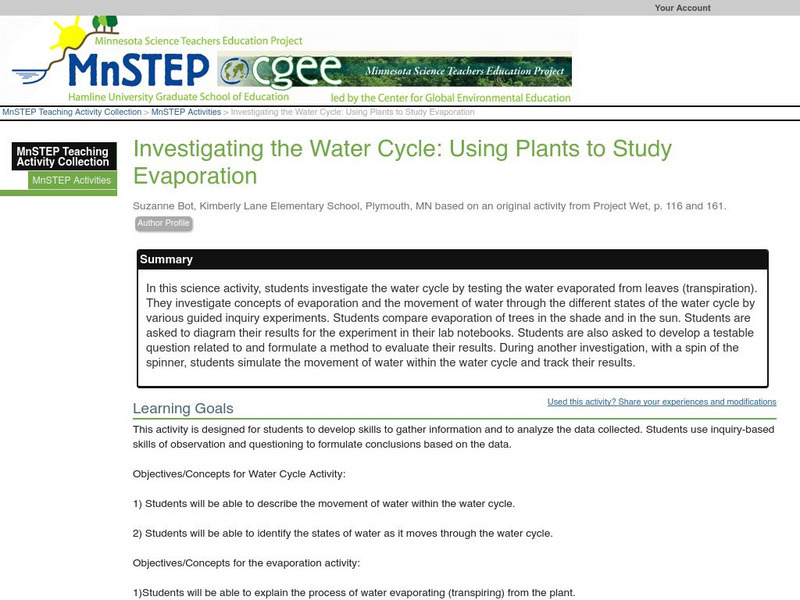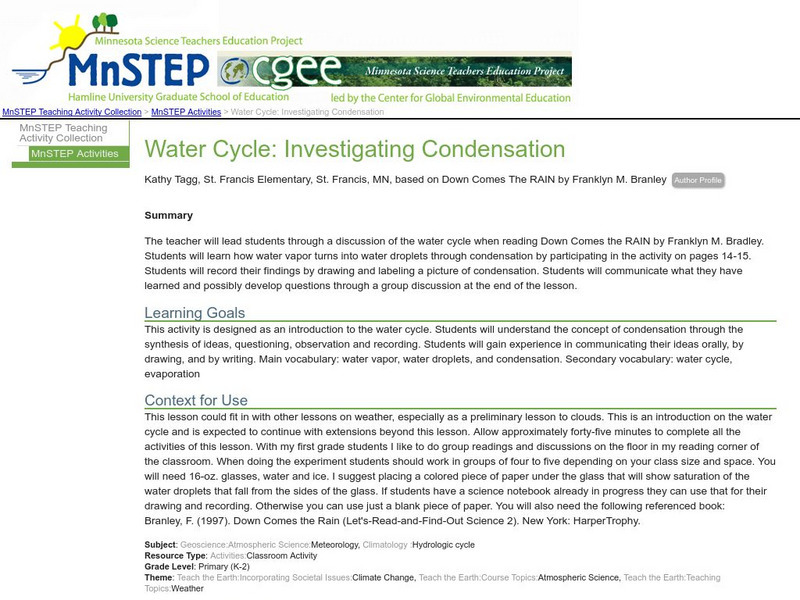Hi, what do you want to do?
Curated OER
Selecting Soil Organisms in Compost
Students demonstrate that many of the enzyme systems needed to break down--and therefore clean up-society's wastes already exist in nature among the decomposers. They select the best starch-munching organisms by altering the environment...
Curated OER
Tulips: Predicting the Arrival of Spring
Middle schoolers use the blooming of tulips as a tool to measure spring's journey north. They predict when tulips bloom at 13 selected Journey North gardens in various geographic regions.
Curated OER
How a Caterpillar Becomes a Butterfly
Student role play and draw the various stages an insect goes through to become a butterfly. They discover the different stages of how a caterpillar becomes a butterfly. Young scholars read The Very Hungry Caterpilla by Eric Carle.
Curated OER
Make Way for Wild Migrants
Students discuss the threats facing migratory species and track the seasonal journeys of wildlife in real space and in cyberspace. Once they have gathered information from several sources, they create a portfolio to share with others...
Curated OER
The Effects of Ultraviolet Light on Lumbriculus
Students explore the effects of ultraviolet light on Lumbriculus. They expose ultraviolet light to Lumbriculus (worm) and determine the lethal exposure time. They examine the worm and record their observations.
Curated OER
Spring Awakenings
Students observe changes in a selected tree bud/leaf during spring. They record changes in the bud/leaf using words, pictures and numbers. They understand that trees adapt to changes in temperature, light, and moisture by sprouting leaves.
Curated OER
Floodplains in the Field
Students measure a topographic and geologic cross-section across a floodplain using simple surveying and auguring techniques in a field lab. Students also reconstruct the history of a river system.
Curated OER
Youth Engagement
Young scholars examine and then discuss opposite sides of controversial issues such as neighborhood curfews, lowering voter age, etc. They learn civic responsibility and cultivate tolerance for others' opinions.
Curated OER
Air Pollution Over Where?
Learners predict the movement of an air borne pollutant using their understanding of air currents. They determine which governments and/or communities should be contacted to be forewarned. They also explore the properties of their...
Curated OER
Plastics and Rubber: What's the Difference?
Students observe how to classify things into groups based on physical properties. In this plastic and rubber lesson students group and sort items to help them to better identify properties.
Science Education Resource Center at Carleton College
Serc: Investigating the Water Cycle: Evaporation
In this water cycle activity, learners investigate the evaporation process by participating in an outdoor evaporation experiment held on the school grounds. Students will determine where evaporation takes place the fastest and how nature...
Utah Education Network
Uen: Water Cycle
Activities demonstrate how the water cycle maintains itself.
Utah Education Network
Uen: A Water Cycle Chamber
Activity helps with understanding the water cycle.
PBS
Pbs Learning Media: The Sun and the Water Cycle
Learn about the water cycle through the adventures of two sisters. They will explain how the sun powers the water cycle and describe the different states of water. A glossary and labeled illustrations accompany the video. For the...
PBS
Pbs Learning Media: Kids in Motion: Water Cycle Fitness Lesson Plan
In this lesson, students unite science and physical activity to learn about the water cycle!
Science Education Resource Center at Carleton College
Serc: Investigating the Water Cycle: Using Plants to Study Evaporation
In this science activity, students investigate the water cycle by testing the water evaporated from leaves (transpiration). They investigate concepts of evaporation and the movement of water through the different states of the water...
BioEd Online
Bio Ed Online: Water
The Science of Water Teacher's Guide provides a number of inquiry-based activities for grades 3-5 (although it can be expanded for other grades). The guide contains science lessons that enable students to explore water, behavior of...
Science Education Resource Center at Carleton College
Serc: Investigating the Water Cycle "Snow Fun"
In this teacher directed inquiry indoor lab students collect snow in a cup. They will estimate how much water will be in the cup after the snow melts. Students will then make predictions about what will happen to the cup of water. After...
Utah Education Network
Uen: Trb 4:1 Investigation 6 Water on the Move
Activity provides an understanding of the water cycle.
Alabama Learning Exchange
Alex: Water Cycle Model
This hands-on model of the water cycle is a great culminating activity for a study of the movement of water through the environment. Completed in small groups or as a class project, it involves connecting three bottles to demonstrate the...
Utah Education Network
Uen: The Wonderful World of Water
These activities will help students understand the properties of water.
Science Education Resource Center at Carleton College
Serc: Mn Step: Singing the Water Cycle
For this activity, students learn about the water cycle by singing and acting it out.
Science Education Resource Center at Carleton College
Serc: Mn Step: Water Cycle: Investigating Condensation
Students will listen to a story about the water cycle, observe how water droplets form on a glass of icy water, then draw and label a picture showing condensation.
Science Education Resource Center at Carleton College
Serc: Mn Step: Weather/water Cycle
In this activity, learners will learn about the water cycle through a story, a song, and a game, and relate it to the weather that they observe.























